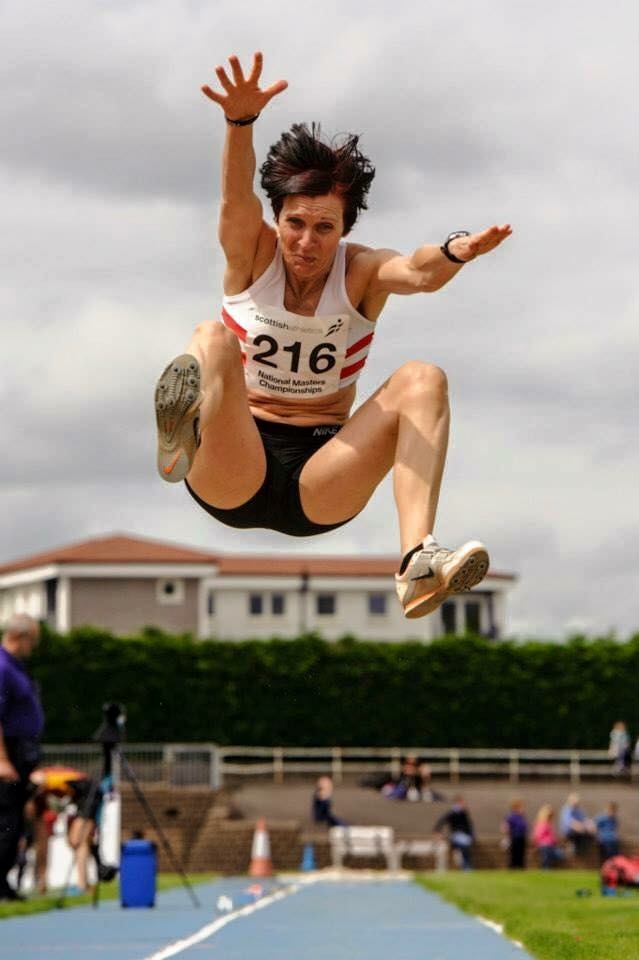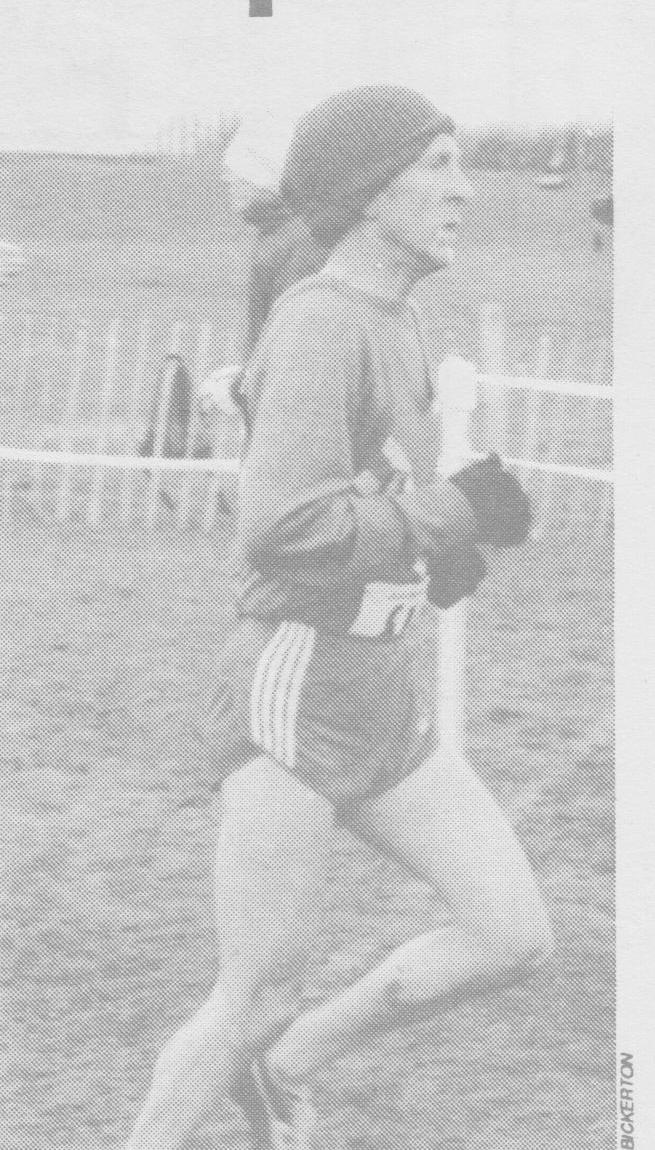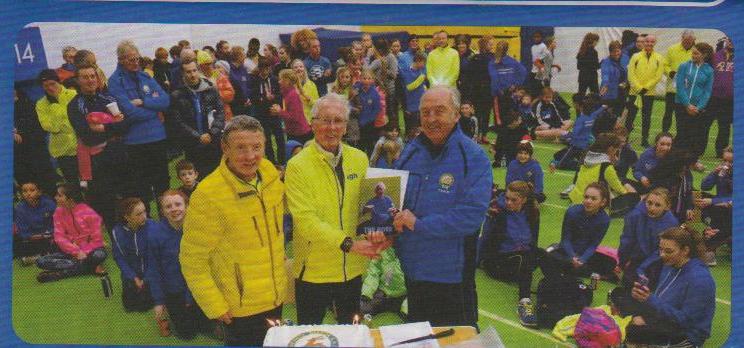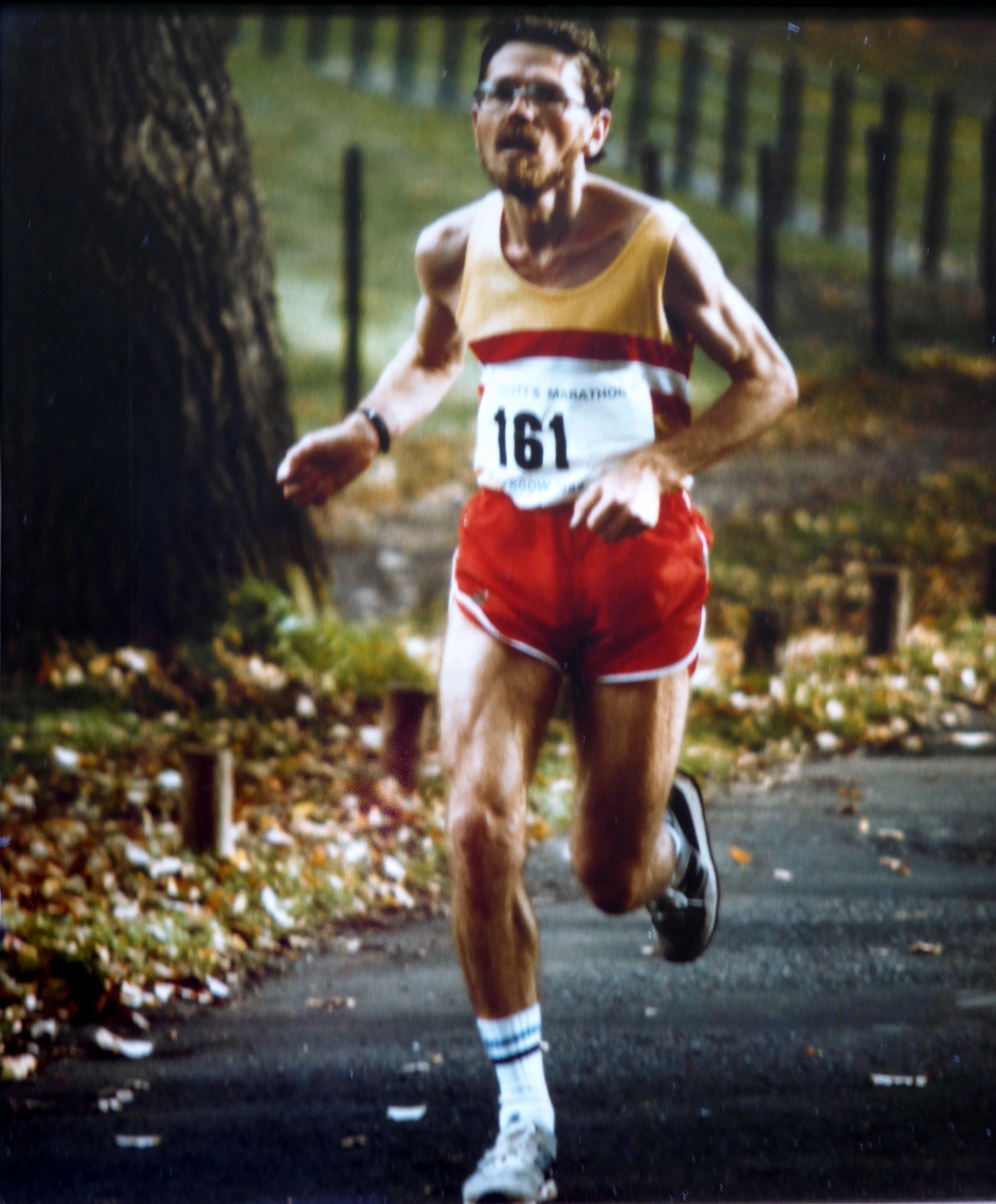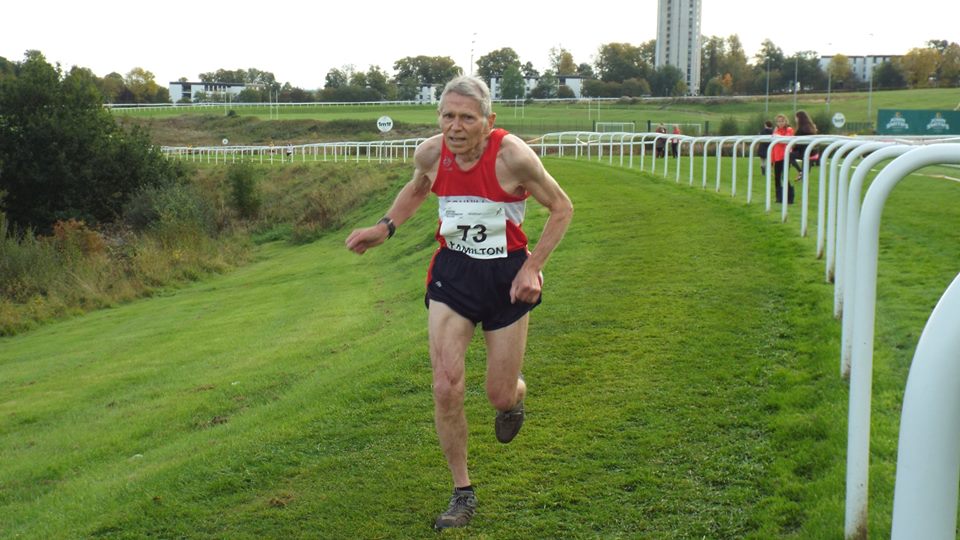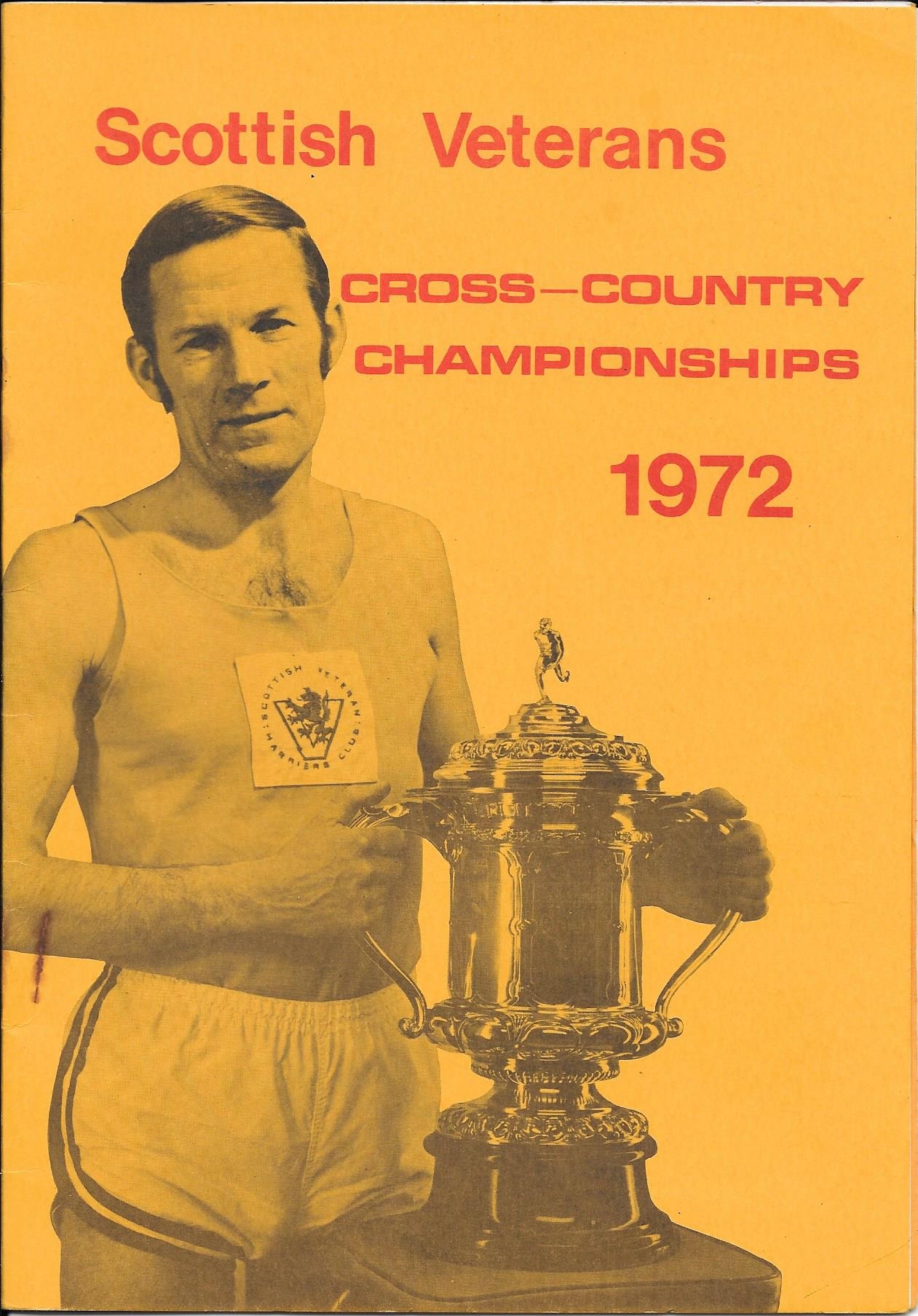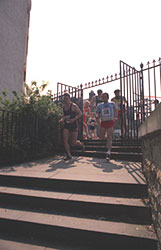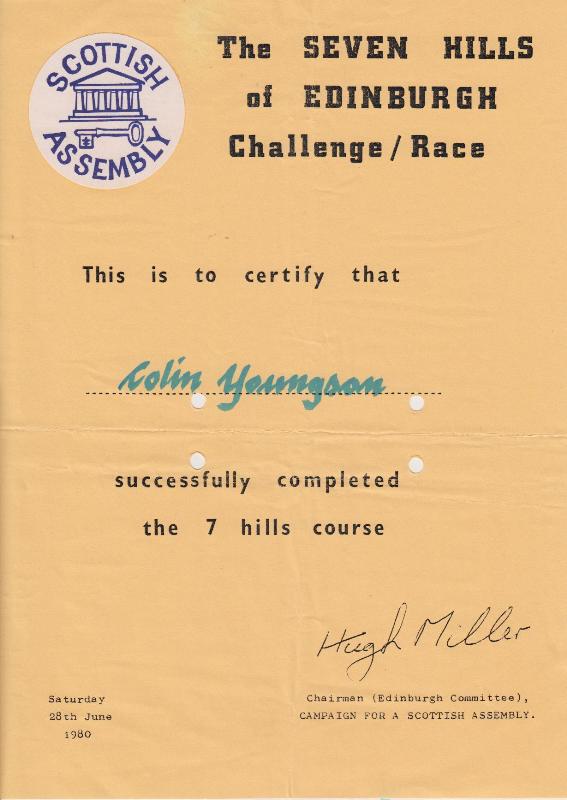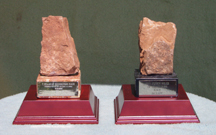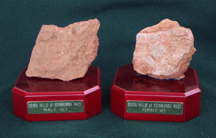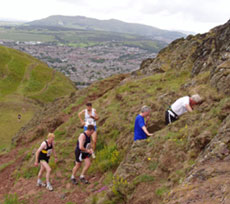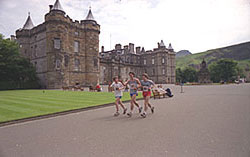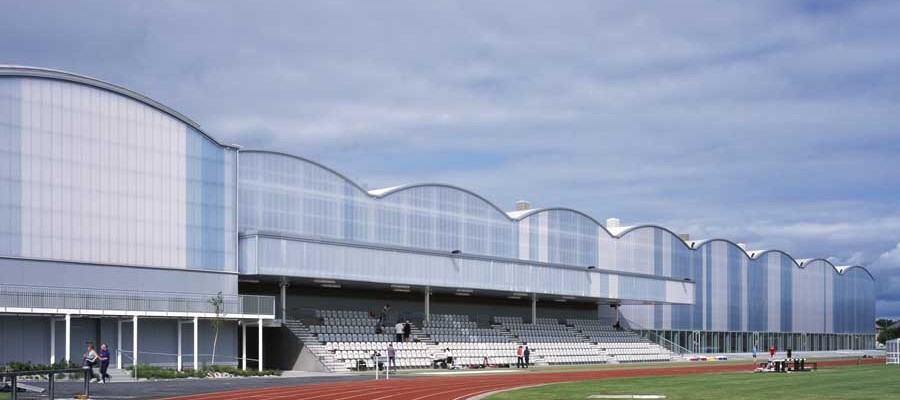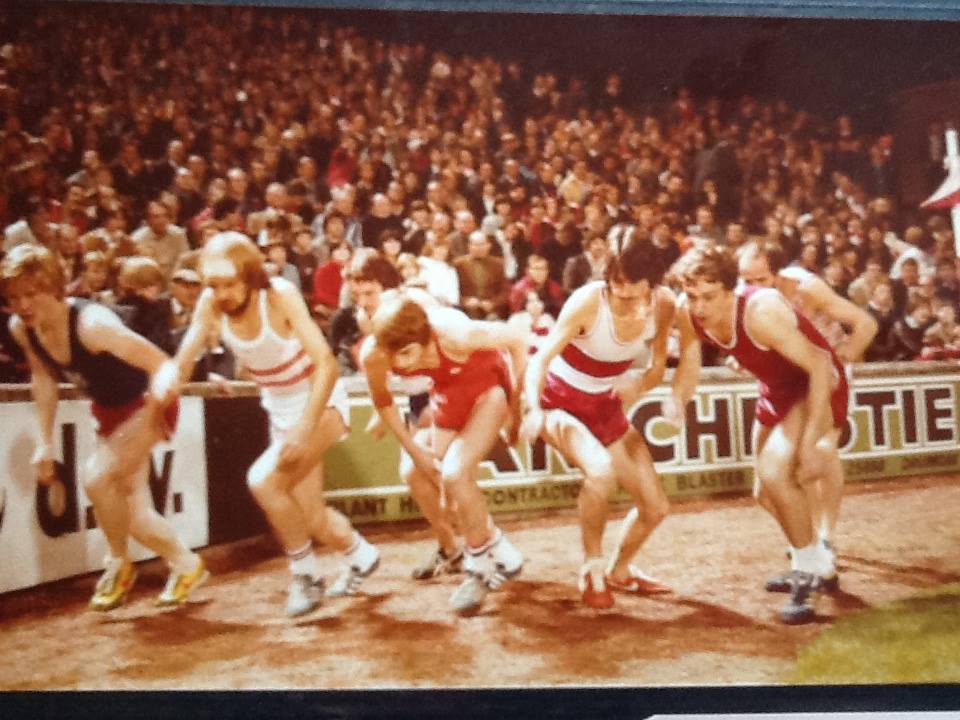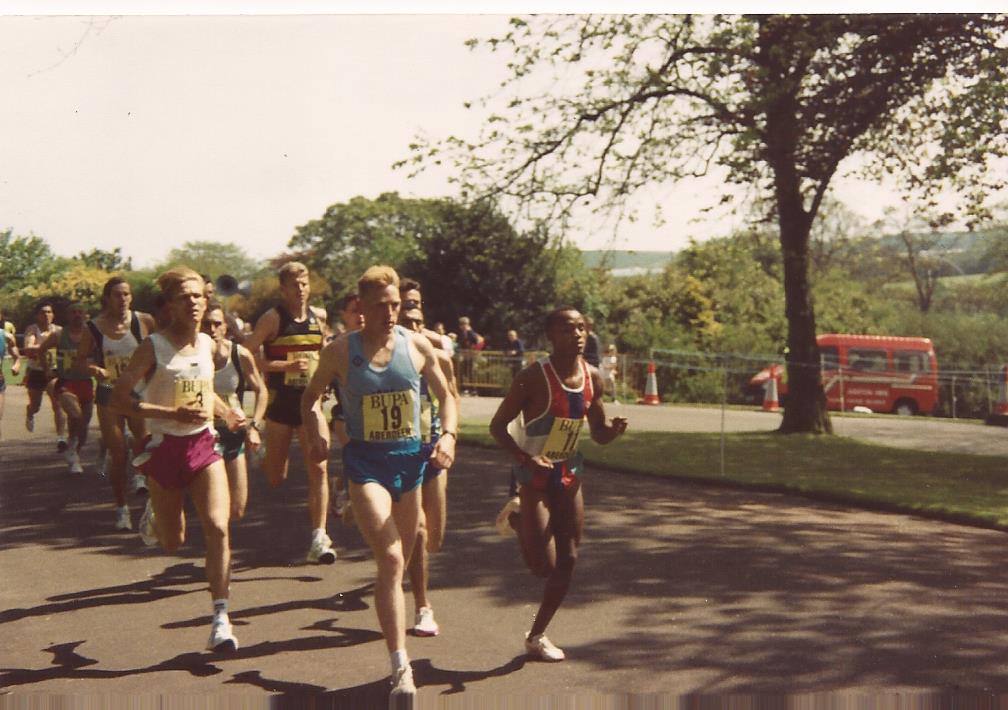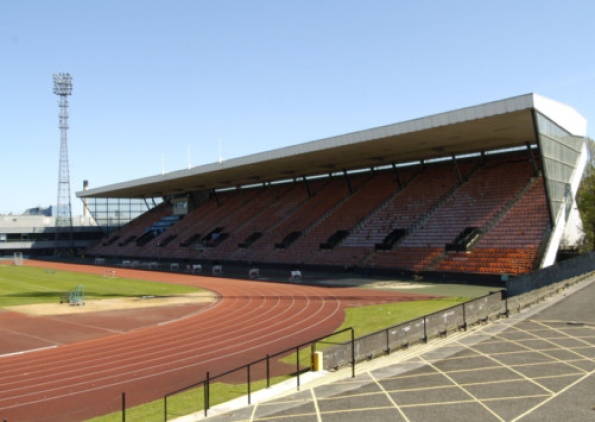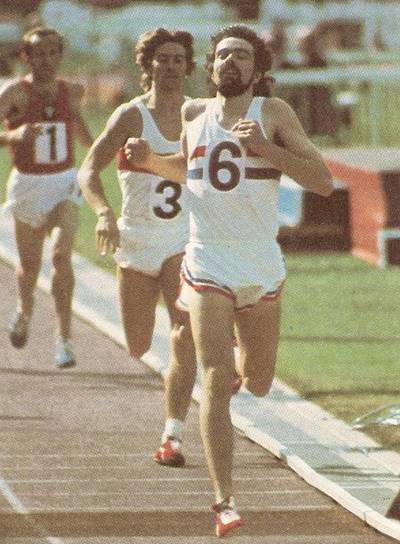FUN AND GAMES
As the battered blue Volkswagen careered northwards, the three students tried to relax. Surprisingly for early July in Scotland, weather conditions were sunny and still.
“Fine day for the Highland Games,” exclaimed Alan Simpson, “Hope it doesn’t get any hotter, though, or I’ll melt during the road race.”
“Tough luck,” laughed Tony Harris, “You should stick to real athletic events. The grass track will be drying out nicely for me.”
“You’d better hope those lunatic bikers don’t cut it up,” commented Charlie Middleton, “Not that I care. The track will seem as smooth as a snooker table, if I reach the finish of the hill race.”
“There, there, Charlie,” soothed Alan, “We know it’s your first attempt at hill running. But if you’re a good boy and don’t break your neck on that nasty terrifying vertical descent, I might even buy you an ice-cream!”
“You really know how to cheer someone up,” Charlie moaned, “I’m dead worried about this, you know.”
“Never mind,” said Tony, “You’ve just got pre-race nerves – we all do. Think of it as an enjoyable challenge to overcome.”
“Anyway,” Alan added quietly, “With Dad driving you might never reach the start. Let that be a comfort to you.”
Old Jim Simpson, Alan’s father, said nothing, as was his habit, and concentrated fiercely on his task. Gradually the others lapsed into silence also. They coped with the stress of the journey by dozing, watching the road unfold rapidly, or even praying, when absolutely necessary. Jim was sixty-one years old, and as fit as most thirty-year-olds. He was extremely hard-working and prided himself on his smart attire and politeness. From the shining toes of his formal black shoes to his immaculately combed hair, he was every inch a gentleman. But although he never swore and had no real vices, Jim was a demon behind the wheel. The Beetle roared up the middle of the road, dominating the white line and skidding violently round corners. Its engine, which normally ticked over like a contented sewing machine, protested as Jim’s foot pressed ever harder on the accelerator, searching for the power of a souped-up Ferrari.
Almost the worst recurrent situation was when the Volkswagen was baulked by a slower vehicle. Jim could not overtake because of bends or oncoming traffic. He fretted ferociously about road hogs and cripples and imbeciles. The worst situation, of course, was when he declared with grim intent, “Right! Next straight I’m going to get this blighter!” His unhappy passengers knew he would be true to his word. He would not be deterred by minor obstacles like the three ponderous Furniture lorries thundering relentlessly head-on towards the bonnet of the overtaking Beetle, apparently ready to crush it contemptuously under-tyre as if it were truly an insect. Miraculously the Volkswagen escaped without a scratch. Possibly because of the communal prayer and wail, or Jim’s frequently underestimated steering skills. By the time they arrived at the Games car-park, the three athletes had little need of a warm-up, they were sweating so much.
“Never thought we’d make it!” gasped Charlie.
“Didn’t trouble me at all,” lied Tony, “A few hours rest in Intensive Care and I’ll be ready for the trip home.”
“I was not aware of any difficulties, gentlemen,” asserted Jim in a hurt tone.
“Anyway, we’re here now, so let’s get changed and ready to run. The road race starts in half an hour,” Alan cut in, “Okay if we meet afterwards in ‘The Red Dragon’?”
There was general agreement, because the pub, which had once been famous for selling the most northerly real ale in Britain, was one of the main reasons for attending this particular festival. Poor Charlie, still travel-sick, muttered dismally, “I could murder a pint right now.”
Once he had been convinced that real hill runners had no need for Dutch courage, the three younger men departed with their kitbags. Old Jim strolled off to buy a programme and spectate from a sunny vantage point.
For a Highland Games, the setting was perfect. A closely-shaven grass track was marked out on a broad undulating expanse of lush parkland, with acres of open ground to accommodate athletes and onlookers. Between the main road and the arena was an avenue of mature deciduous trees and the town gardens – fountains, topiary and vivid flower displays. Behind the Games venue, the land rose abruptly into a series of small steep wooded hills, culminating in a lofty tower dedicated to Admiral Nelso. From there one could view the fertile farmland and forests of Moray, against the backdrop of the blue Cairngorm Mountains.
Encircling the track were hundreds of folding chairs, painted white, with spacious marquees for changing and the sale of local produce. To one side a small funfair adjoined the car-park and public conveniences. Directly opposite, a whitewashed rustic pavilion served refreshments and provided first aid for over-enthusiastic competitors. Few required it. This was a delightfully low-key amateur occasion.
Sightseers applauded a Pipe Band as the musicians marched proudly, heads high and kilts lilting, round the track. The stirring strains of ‘Flower of Scotland’ rang out. After they departed the announcer, a local worthy with a dreadful sense of humour and unbearably boisterous bonhomie, welcomed everyone to the Games. As he chuntered on amiably, Jim Simpson ignored the tannoy and inspected his programme. He skimmed through the list of events, identifying only the order of his favourites. Cycling first; the ‘Heavies’; and finally the Sprints. He sighed with satisfaction as he settled down to survey the high-speed drama of the Grass Track Cycling, which seemed to him almost as thrilling as Formula One Motor Racing.
Starting proceedings was the shortest sprint, the 800 metres. Ten kamikaze bikers lined up, clad in full Tour de France gear – long thigh-hugging black shorts, multi-hued shirts and obviously inadequate leather crash-bunnets. The gun fired and they charged madly into the first bend of the two-lap race. Although the surface of the well-cut grass was quite dry, moisture lurked just beneath. The centrifugal force of ten sets of tyres, cornering at speed, started to churn up the edges of the track. Surprisingly everyone stayed in the saddle but a lean young daredevil, trapped at the back of the pack, swerved into the outside lane and attempted to surge past before the end of the straight. He succeeded in doing so but omitted to plan his next manoeuvre – negotiating the curve. By dint of skidding off the ropes and digging his right heel into the turf he managed to prevent himself from ending up in a startled sunbather’s lap. Unfortunately he over-corrected and sped into another rider’s rear wheel. There was a clash of metal, some muffled swearing, and both men and their machines, hopelessly entangled crashed into the fence. Without a sideways glance, their heartless rivals slewed round the wreckage and shot down the home straight into the final circuit.
As the bell rang a stocky figure, with brown bulging thighs as thick as pregnant telegraph poles, hurled himself to the front and made a long burst for the finish line. Judging by the way he slung his bike round the bend, he must have been super-glued to his seat and his tyres metal-studded. Straining every muscle he zoomed into the last hundred metres – and then could only groan with disappointment. A cool confident figure, who had slipstreamed his ever move, switched on maximum power and swept past to win by a wheel’s width. Rolling easily into a warm-down lap, he accepted congratulations with poker-faced grace.
Old Jim shook his head admiringly, thinking that cyclists were tough, fearless gymnasts and certifiably crazy. Later in the afternoon there were four more races for him to relish. In the Senior 1500 metres, one hardy hero slalomed helplessly through sludge into the crowd. The Junior 1500 featured the collision of two youthful hopefuls – one buckling a back wheel, the other a collar bone. The 6000 metres was without incident apart from a repeat victory for the last-minute ‘kicker’ who had snatched the 800 earlier. But the “Deil Tak the Hindmost” was a fitting climax to the series.
Seven scarred Samurai survived to endure the torments of this particular circle of hell. The name of the race sums up the callous lack of sympathy for losers in sport. After a smooth start and a preliminary tour of the track, the fun begins. On every second lap there is increasingly frantic jockeying for position followed by a bunch sprint. Last one over the mark is eliminated. He peels disconsolately over to the sidelines while the rest of them start the 800 metres build-up again.
Some cyclists seem to have that slight but significant advantage in speed which separates a sparrow-hawk from its prey. The fellow who had won twice that afternoon seemed to have the edge on his opponents, such was the ease of his progress into the ‘final’. Exuding class and nonchalance he glided into the ‘recovery’ lap, preparatory to enjoying near-certain success. He acknowledged the cheers of his admirers and then was unnerved by a strange sense that he was on his own. Realising rapidly that there was yet one contest to conclude, he glanced round for his rival and was astonished to spot a short muscle-bound figure, head down, streaking away down the back straight! Eager to avenge his defeat in the first race, the stalwart second-placer had taken his chance and sneaked off very early to ‘go for gold’. Desperately the ‘superior’ one shot off in pursuit and had reduced the leeway to twenty metres with one lap to go. However his finishing burst had been used too soon and he had to rely on staying-power and mental strength to peg back his adversary any further. Foot by foot he strained ever nearer and it seemed possible that he might just win after all. Then two things happened simultaneously. The stocky one somehow managed a last leg-blurring lunge for the line; and the Seb Coe of Northern Scottish cycling sagged (doubtless the victim of some mysterious virus?) his tyres lost traction and he slithered, elegantly of course, to the ground. A victory for stamina and smart tactics – and a warning against over-confidence and lack of alertness. Remembering the title of the event, the response from Jim and the rest of the crowd to the star’s demise was loud laughter! ……………………………….
After the Games, Jim looked forward to telling his passengers about the highlights of his afternoon. He was well aware that they would have been wrapped up in their own events and would have observed little else. However his good manners made it difficult to get a word in. He found them relaxing in that unspoilt wood-panelled traditional Scottish bar ‘The Red Dragon’, which is famed for beautiful booze, a welcoming atmosphere and remarkably untalented darts players. Alan was drenching a marathon thirst with his second glass of orange squash, but had the grace to buy his father a shandy. Charlie was attempting to drown himself in pint-sized pools of real beer – McEwan’s 70 Shilling Ale.
Having lubricated the lining of his throat, Tony stretched luxuriously and drawled, “Well, aren’t you going to ask me how I got on this afternoon? Jim was watching but you two weren’t.”
“Suppose so,” muttered Charlie, “If you listen to what happened to us.”
“Love to,” Tony stated sarcastically, “But me first.”
“Okay – just don’t take too long, big head,” Alan chipped in.
“Right,” promised Tony, “Well it was like this. I felt really good in my warm-up for the 1500, bouncy and loose. That steeplechaser guy was running. You know – Bill Edwards. He looked very cool and easy doing his strides, joking with his mates – perhaps he thought it would be no contest. After all he’d won both the 1500 and the 3000 last year and he didn’t know me from Adam.”
“No wonder – you only ran 4.25 last year,” commented Charlie dismissively, “What a fat sod you used to be, Harris!”
“Fair enough,” Tony agreed, “Though I had a better social life in those days. But Edwards couldn’t have known about my extra training since Easter – and neither did the handicapper! I was off ninety metres in front of scratch. So I reckoned, right, this was my chance to sort out a really good guy at last. Since that coach came to the University pre-season, I’ve been sticking to his schedule like a demented monk. It’s been hard work but I’ve been chipping away at my personal bests and the last two weeks I’ve felt more like Steve Ovett than my old self. My last serious session was on Wednesday: up the clock 200 metres with a minute’s recovery; 400 with 90 seconds; 600 with 2 minutes; 800 with three minutes; and then all the way down again. I was absolutely flying! Massacred Alec Forbes and knocked five seconds off the 800 training ‘record’.”
“Cut out the gloating,” protested Alan, “You know Alec’s just had ‘flu!”
“Yeah, but he’s always pretty fast,” asserted Tony, “And I tell you – I’ve never felt so fit in my life. A couple of easy days and I was set up for this afternoon. Anyway, the starter gets us sorted out and I’m standing on my mark ready to go. I glance back at Bill Edwards and he’s waving at a girlfriend in the crowd! The gun goes and woosh! I’m off like a real bullet, not a blank this time. Bill’s still moving into gear and I must have stolen another twenty yards on him. You must have seen it, Jim! Mind you I didn’t look behind again – just kept going flat out. Three laps to go and there’s only one old guy in front and he’s going backwards. No problems with the legs and breathing controlled. Two laps to go – no hassle. Gets a bit tougher then – some of that lactic acid building up, legs getting heavier but they’re still pumping away fine and I’m in the lead. The bell! I’ve just got to risk a look round – can’t hear any footsteps but still …. What do I see? Edwards is still a hundred yards back! Have to amputate both my legs to lose it now – probably hop to the tape if they only cut one off. Bit of a struggle round the last lap but I was miles in front – at least ten seconds. My time was fast too! In fact if I add on what it would have taken me for the ninety metres, probably I would have broken 4 minutes ten seconds. Not bad, eh?”
“Sounds like a good one right enough, you lucky so and so,” agreed Alan, “Didn’t think you had it in you. Prize okay?”
“Set of reject mugs,” admitted Tony, “But who cares? Anyway, it gets better – Bill didn’t like getting beaten, although he was decent enough to congratulate me. Claimed a shin was hurting but did say I’d have been very hard to beat. Still, he didn’t show for the 3000. It was off scratch, of course, but I was well recovered for it since it was two hours after the fifteen. Just used the same jet-propelled start but settled down quickly and ground out the laps, keeping an eye on the other lads. Had to work a bit near the end but managed to break nine minutes – 8.53. On a grass track that’s pretty good – and another PB of course. I’ve had a great time in fact. Wish they were all like that!”
“I suppose you did run well,” admitted Charlie, “Almost like a real athlete, in fact.”
A real athlete. As they bickered amicably, old Jim sipped his drink and his thoughts drifted back to the Games – and competitors that most spectators would consider to be the real men on show. ………………………………….
Much of Jim’s attention at any Highland Gathering was paid to the ‘Heavies’ i.e. the big men who competed in traditional trials of strength: hurling the Scots Hammer (with the wooden shaft); putting the shot (often a stone); throwing the 28 pound weight for distance; heaving the 56 pound weight for height; and of course tossing the caber.
All afternoon, like a tribe of Mountain Gorillas being observed by David Attenborough these huge individuals padded slowly around the arena, associating only with their brothers and an occasional official (who was almost certain to be a retired Heavy events athlete himself). Jim regarded them mainly with awe, since they seemed to possess immense destructive potential, yet remain such gentle giants. Normal males (let alone seven stone weaklings) felt inadequate just looking at them. Physically, they seemed to be a separate species – the shortest a mere six feet tall but with such breadth of shoulder, brawny biceps and kilt-enhancing calves. Some of the older athletes were notable for well-developed bulging bellies too – but Jim just knew that the fat there would be rock-hard!
They seemed to be at ease, secure in their sense of themselves. If your engine is turbo-charged, if your tank is full of five-star, you can afford to cruise comfortably – the power will be there, should any pipsqueak dare to challenge you. Jim smiled enviously at the thought. With hands on hips and the broadest of smiles, they appraised each others’ efforts with jovial good humour, backslapping, bear-hugs and nods of appreciation.
When it as time for one of these supermen to demonstrate his ability, he moved apart from the perambulating porridge commercial and prepared in a brief and dignified manner. Perhaps stretching a little, loosening a knotted muscle or even jogging a few sedate strides. Then, without sign of strain, he selected his missile and took up the appropriate position. There was a breathtaking surge of strength and speed, an animal roar, and the object arced through the air before plunging, bouncing, denting deeply and resting heavily on the scarred turf. The muscleman ambled back to the brotherhood.
Jim considered the caber to be THE heavy event of the Games. He relished the practised ease with which the awkward length of heavy timber was raised to the vertical then lifted to knee height before the rapid little run and almighty heave which sent the tree-trunk end over to land perfectly at ‘twelve o’clock’ straight out in front of the thrower. Weaker athletes were found out by this implement, and displayed symptoms of stress (or imminent apoplexy): the crimson face, sweat pouring from the brow, dire groans and finally the uncontrolled staggering rush to release the caber – squint.
However Jim was sure that the most dangerous stunt was hurling the weight over the bar. He could hardly bear to watch every time it happened. Nonchalantly, one of the warriors lugged a four stone lump of iron to the mark directly beneath a pole-vault bar. Straddling his legs, with both fists he grasped the ring attached to the weight and swung it backwards between his knees, brushing his kilt aside. Then he hurled the missile skywards above his head, aiming to arch it over the bar. Just before this deadly blunt instrument descended, he strolled away casually, narrowly avoiding lobotomy, decapitation or merely skull-crushing. Jim and the rest of the crowd sighed with relief or disappointment and the next candidate for execution stepped forward steadily. No matter whether the reason for such behaviour was confidence, fearless bravado, lack of imagination or sheer suicidal stupidity, Jim considered the ‘Heavies’ to be a race apart. ……………………………………………..
A race of a different character, much rougher than Tony’s track athletics, also appealed to the mildly sadistic spectator. Jim had been fascinated to watch the more hapless hill runners skidding helter-skelter down the final steep slopes before staggering round the field to the finish of the four mile Hill Race. Back in the pub, he regained concentration, just as Charlie was describing his experience.
“It all began well enough,” he remarked, shaking his head dolefully, “You remember what a good cross-country season I had? The muddier it got, the further up the field I finished. Wind, rain, snow, uphills, cliff edges – it was all the same to me. I guessed the tougher it got, the better. Must have thought I was a hero or something. And I’ve never had any real leg-speed when it comes to the track or the road, so I made up my mind to try the hills this year – I’d be a fell-runner or bust.”
“Well you’ve made it to The Red Dragon,” declared Alan, “So you obviously didn’t bust. What happened?”
“As I said, it was no bother at first. Three times a week for the last month I’ve been doing hill repetitions – even up that monster sand dune at Balmedie. So the steep climb up the winding little path through the woods felt okay, although it was irritating when Mel Ewing decided to run beside me. He kept yattering on about how well I was doing for a new boy, while we were actually hauling ourselves up the scree slope at the steepest bit! Maybe he meant to encourage me but I started feeling inferior because, unlike him, I hadn’t developed an extra lung to talk with while the other two were panting like a pair of Pekinese scaling the Eiger!”
“So what went wrong?” interrupted Tony.
“The uphills I could cope with,” continued Charlie, “And I kept bashing on in third place all the way to the summit of the fourth and final top, round the Nelson Tower – and then the trouble started. When I tried to read the map before the race I just got confused so I didn’t bother and thought I’d simply follow the faster men. But because I was so far up, and the first two (including Mel, who’d got away) were a hundred yards in front, I went wrong on the first downhill. They totally abandoned the path (which wound round backwards and forwards at that point) and disappeared into the undergrowth straight down the hillside. Well, I thought I’d better try to follow them, so I dived off the path myself. It was sheer murder – tree roots and thorn bushes. When I did find the path again lower down I got muddled and turned left instead of right. Didn’t know my mistake until the lad who’d been fourth crashed into me face-first! Then I started straining a hamstring on a slippery descent so I had to slow down on the fastest sections. All sorts of OAPs, weight-watchers and wheelchair athletes started to come past – some of them were crazy on the dangerous bits. I swear those guys can put a foot into a rabbit hole and take it out again before their ankle snaps! What a technique – I’m sure one nutter whizzed past me upside down! My quadriceps were killing me because I had to brake so hard on the really treacherous parts. I only must managed to stop myself falling down a waterfall. When I finally tottered into the field I was frustrated and furious at myself. I charged round the last half mile of park to the finish. Must have overtaken ten on that stretch, but still finished only fifteenth, in a bad temper, with knackered legs. What a sickener!”
Alan managed to stifle the laughter he felt bubbling up and tried to sympathise. “Hard luck, Chas. But don’t give up yet. It’s just a matter of training on the downhills as well as the climbs. Try a few strides on Brimmond Hill when your muscles recover.”
“Maybe,” replied a doubtful Charlie, “Although the way I feel now – absolutely pulverised – I may never be able to run again. What gets me most is how embarrassing it was. The only good thing about trailing in, five minutes after the winner, was that most of the crowd seemed to be concentrating on the big Sprint Handicap, rather me and the other war-wounded.”
Jim smiled to himself as he remembered the event in question. …………………
In a normal hundred metres race, competitors start level with each other and finish apart; whereas in a properly-handicapped Highland Games event, very nearly the opposite may be the case.
Pre-race drills remain the same, however. Jim had observed representatives of the two types of sprinter – short strong scrum halves and big bear-like bruisers – carrying out their routine with stern religious intensity. Swaddled in heavy sweatshirts, whatever the weather, lone figures reeking of embrocation plodded with painful slowness round the outfield, fast-twitch muscles protesting at excessive distance. Then, reluctantly, they completed a second circuit. Ten minutes of rigorous stretching ensued: bending, sitting, lying or apparently trying to fell a tree by pushing it over. Cautiously, they removed a single layer of clothing, and then, self-absorbed and solemn-faced, they strode out monotonously down a suitable stretch of grass, with repetition strolls back to their discarded kit.
At this juncture a few starting blocks (which are seldom in evidence at the Games) were hammered home and painstakingly adjusted until perfect. A series of sprint starts followed, violently punching fists and exaggerated knee-lifts – ecstatic explosions which fizzled out limply after a few anti-climactic seconds.
Finally on this occasion the starter, a natty oldster in red blazer and jaunty peaked cap, called them to their separate marks. These were as much as twenty metres apart, depending on prowess or decrepitude displayed during the previous season. “SET!” In slow motion, rumps reared. “BANG!” At the report of the gun the ‘Scratch Man’ (insultingly named but impeccably hygienic) who had furthest to run, leaped into action just before his less alert rivals. One evergreen competitor, an old bald but indomitable chap in long khaki ‘shorts’, reacted eventually by standing up straight and scuttling stylishly (but with little stiff strides) towards the halfway point. By this time he had been overtaken by a loping lad in a rugby jersey. Meanwhile the faster men were hurling themselves down a tunnel of concentration towards the tape. To a crescendo of shouts and applause, it was snapped by the backmarker, whose legs twinkled like a well-oiled hyperactive metronome as he dipped expertly at just the right moment for him to tumble into an unintentional but well-disguised forward roll. Copying their American counterparts, the more extrovert athletes indulged in a hand-slapping demonstration, but only succeeded in looking like fitter versions of Laurel and Hardy.
Jim enjoyed the spectacle but then listened intently as a tannoy announcement was made about a special event to be added to the programme. ………………………
In the bar of The Red Dragon, after Charlie had told of his disappointment, Jim bought the next round. “Of course I myself will drink only mineral water from now on,” he announced selflessly, “Since I do not believe in over-imbibing and in any case must retain a clear head for the drive home.”
The others exchanged perturbed glances at his but did not comment on their joy at the prospect.
With a heavy sigh, Alan said, “I suppose you’d better hear what happened to me in the Road Race.”
“You mean you didn’t win it?” inquired a puzzled Tony, “I thought you’d walk it.”
“Well there was that local runner Sandy Macmillan,” Alan responded, “But I must admit I thought he was past his best. Anyway there were about a hundred competitors but only Macmillan and I had a chance of victory. A wee bunch of six stuck together on the little circuit round the houses. Since I felt comfortable and wasn’t too sure of the route I just settled in until we hit the country road and started the nine mile loop. First long uphill drag I sank the boot and tried to drop the rest.”
“And did you?” asked Charlie.
“Almost. I pushed really hard for half a mile but I could hear one guy’s footsteps close behind. There was a headwind so I sidestepped and let him be the windbreak for a while. It was Sandy Macmillan of course. He was puffing a lot but going well. Then I tried a series of shortish surges and managed to gain a twenty yard lead. This stretched painfully slowly to fifty yards but it was tough staying clear – he just refused to let me go completely and kept hauling me in on the down-slopes. You would have thought we were attached by a big rubber band. The old nuisance must have been on a course of steroids. Anyway, about seven miles I got sick of the strain of being just a little way in front so I went absolutely eyeballs-out for ten minutes without looking back at all. When I finally glanced over my shoulder, he was a good two hundred yards behind. What a relief!”
“So how could you lose?” asked Tony, mystified.
“Listen and I’ll tell you. I eased back a bit in the last couple of miles, just cruising home or so I thought. One mile to go and Sandy well beaten, I reached the bottom of the hill near the park. There was no sign of any officials marking the route so I followed the main road and suddenly got a shock – I was running past the door of this pub! Ten seconds later I found myself in the main street! Realising too late that there was something wrong, I veered right and sprinted up to the front of the park and tried to find an entrance. I had to force my way through a queue for ice-cream and past a ticket seller before I got near the track. Of course I had flipped completely by then – you know my rotten temper under stress. I was raving like a Rangers supporter after a loss to Celtic, swearing blue-nosed murder at spectators and especially officials. I moaned about the lousy marking on their stupid road race. Naturally, by the time I’d grumped my way round the last lap to the finish, I was fifth. And what I couldn’t believe was when I went up to Macmillan to tell him what had happened. Turns out, he saw me go straight on instead of having the local knowledge to turn right up a lane. Claims he tried to shout but was too far behind for me to hear. Probably a very quiet shout if you ask me. Then he has the brass neck to say this to me. “Pity to defeat you this way, Alan – but a win is a win.” Then he coolly accepts the cup and first prize and saunters off! If I had been him, and two hundred yards behind with a mile to go, I would NEVER have done that – I know when I’m beaten, fair and square.”
Charlie and Tony stopped laughing at Alan’s rueful face and tale of woe to sympathise, to some extent anyway. Alan’s final comment was that he was beginning to see the funny side now and wished he hadn’t sworn so violently at everyone. Perhaps the Games Committee would refuse his entry next year!
“It is my opinion,” old Jim interrupted gravely, to everyone’s surprise, “That members of the Games Committee are totally incompetent and thoroughly untrustworthy!”
“What do you mean?” quizzed Tony, “It’s still a very good Highland Games even if there are a few cock-ups.”
“This afternoon, gentlemen,” James continued with doleful dignity, “Despite enjoying several events as an observer, I was deeply disappointed. My faith in the integrity of my fellow man was dashed. The facts are as follow. At three p.m. approximately, an announcement was made to the effect that, since the weather was clement and it had been noted that numerous mature but sprightly spectators were present, the organisers proposed to add what they termed ‘an extra novelty event’ to the programme. To wit: a ‘super-veterans’ hundred metres sprint for those over sixty years of age. Now I qualify by no less than fifteen months and furthermore consider myself sufficiently fit, because of lifelong attention to matters of diet and exercise. Therefore I made the immediate decision to put myself to this test, which I perceived to be a rare opportunity to measure my condition against that of my peers.”
“Sounds tailor-made for you, Father,” interjected Alan, “If a little short.”
“Indeed, I was aware that stamina rather than speed has been my forte,” Jim concurred, “After all, it was as a miler that I had some success before the last war. Nevertheless I considered that, with the aid of a thorough warm-up, I might complete the course with distinction. I must confess that the prize, half a bottle of my favourite Glenmorangie ten-year-old malt whisky, was an additional incentive. Imagine my discomfiture when, at the allotted time, there came a further announcement. Since only one ‘veteran’ i.e. myself, had entered so far, the judges planned to open the race to those over fifty. My heart sank but I resolved to compete, despite the challenge of mere youngsters. Yet I was shocked when, fifteen minutes later, the sprint was changed to one for over-forties. Finally, after I had spent an arduous hour preparing by walking briskly, carrying out a series of military callisthenics, jogging and striding, the tannoy had the temerity to tell me that the event was cancelled, because of lack of competitors! After due consideration I proceeded to the Judges’ Tent to discuss the situation. I informed them that I was willing to stage a demonstration sprint if necessary but thought it only fair that I should receive my prize. They were a shifty-looking lot – only one of them dared to look me in the eye. He had the gall to refuse my request, refund my start fee and close the tent flap in my face!”
Tony, Alan and Charlie kept their faces straight with difficulty and shook their heads in well-feigned disgust at this dastardly action. However their deadpan façade was cracked wide open when Jim concluded his story with an air of anguish, saying, “Do you know, gentlemen, it is my firm belief that those scoundrels disposed of my Glenmorangie by drinking it themselves!”
If Jim sought shared outrage then he did so in vain. The three young men hooted with mirth at the poor chap’s chagrin. His expression of suffering was more than they could bear – they giggled and guffawed uncontrollably. Eventually, as the irony penetrated Jim’s righteous indignation, the merest trace of a reluctant grin flickered across his face. It became a rueful smile when Alan declared, “Poor old Dad! Never mind. To help you get over the shock we’ll each buy you a whisky. A triple Glenmorangie and water in a tall glass, please!”
As the barman poured Jim’s rightful reward, Alan soothed his parent and delighted his friends by adding, “Of course, you’ll be over the limit for driving home, Dad, but it’s all right, I’ll have my beer once we get back to the city. We’ve had enough fun – and Games – for one day!”
